SARAH HASHIGUCHI
product designer


INTRODUCTION
May 2016 - June 2017 I had the pleasure of working with Product Design Professor Beth Esponnette, and Chemist Casey Check, on research for my Robert D. Clark Honors College Thesis. I am proud to have passed my thesis defense with distinction, and to have been awarded the Interdisciplinary Thesis Award at the 2017 Honors College Commencement Ceremony.
SUMMARY
3D printing offers advantages in customizability, sustainability, cost reduction, precision, and accessibility over traditional manufacturing processes. The limitation of printable materials, however, is still a major barrier preventing 3D printing moving from prototyping to producing final products. My thesis addresses the need to be able to 3D print thermosets (more robust and customizable polymers). The main objectives of this project were to develop a new system of 3D printing to allow for additive manufacturing with rubbers, and to design a product dependent on this method for production that would utilize the resultant ability to manufacture new complex structures in rubber.
STEP 1: printing proof of concept tests by hand
Experimenting with two part silicone and polyurethane prints with varying support materials and sulphur as an inhibitor

silicone inhibited by sulphur

silicone supported by part A

polyeurethane POC (before)

polyeurethane POC (after)
Selectively curing liquid latex by printing with a vinegar solution

printing vinegar in latex

first layer of vinegar in latex

multiple layers
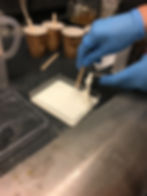
trying to remove the print
Developing different ways to mix the vinegar and latex while printing

experimenting with ways to react vinegar and latex

one syringe inside another

trying to print uniform lines

dried latex (w/o vinegar)
Printing structures with just latex

printing structures
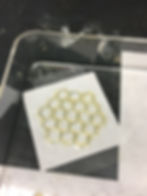
16 layers thick


Tensile strength testing

latex test strip

setting up the machine

stretching the latex
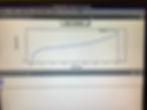
tensile strength graph
Finding a compatable support material

filling glass syringe with soy wax

melting wax in syringe

testing viscosity and material compatibility of support materials with latex

success using poly(tetrahydrofuran)
STEP 2: selection and purchase of a 3D printer machine

ENGINE SR - STANDARD RESOLUTION
High Reliability - Low Maintenance - High Uptime
-
Works with all Hyrel print heads, allowing it to work with numerous materials
-
filaments, liquids, gels, etc.
-
-
Can use multiple heads (with different materials) in the same print
-
Extremely customizable
-
Operated by tablet, allowing gcode revisions on the go
-
Heated bed and cooling fan options
STEP 3: showcase this new manufacturing process for rubber through design
Inspiration: Patagonia's natural rubber wetsuit
Objective: Design a 3D printed rubber wetsuit material that will perform better and be more sustainable than traditional neoprene wetsuits
Theory: 3D printed structures would have the ability to trap more air in more regular patterns opposed to traditional neoprene, and as a result could offer better thermal insulation properties with thinner material
Research:
-
neoprene material properties
-
wetsuit manufacturing
-
other innovative insulation solutions for wetsuits
-
interview a surfer
CAD: try printing different options and test which one works the best
STEP 4: practice and refine printing the CAD file by manipulating gcode






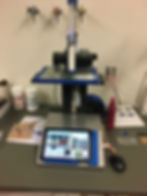
printer set up

printing just latex
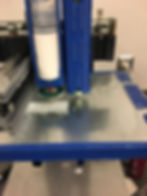
trying to calibrate both heads

printing one large cone with latex and poly(tetrahydrofuran)

printing an enlarged version of one of my patterns

printing a pattern at 1:1 scale
STEP 5: write a paper for the Journal of Additive Manufacturing
When I graduated in June 2017, I handed off my work to graduate students in the Material Science Institute Graduate Internship Program to work on over the summer. Their job will be to continue overcoming some of the issue we ran into such as optimizing speed and flow rate by monitoring the following variables:
-
Material type
-
Extruder/print head
-
Flow rate from extruder
-
Temperature (of print head, and print bed)
-
Nozzle diameter
-
X-Y speed
-
Z height
Due to unexpected challenges programing the printer, I did not complete testing the insulation properties or tensile strength of the different patterns I created, so the graduate students will be addressing these as well. The journal article will instead cover what we have learned so far about developing a method to print with latex and finding Poly(tetrahydrofuran) as a compatible support material. The current plan is to write and submit the article in August 2017 (stay tuned for publishing updates). My hope is that this research will serve as a foundation to inform and inspire others to build off of in the future.
Thesis Work Mentioned in These Articles: